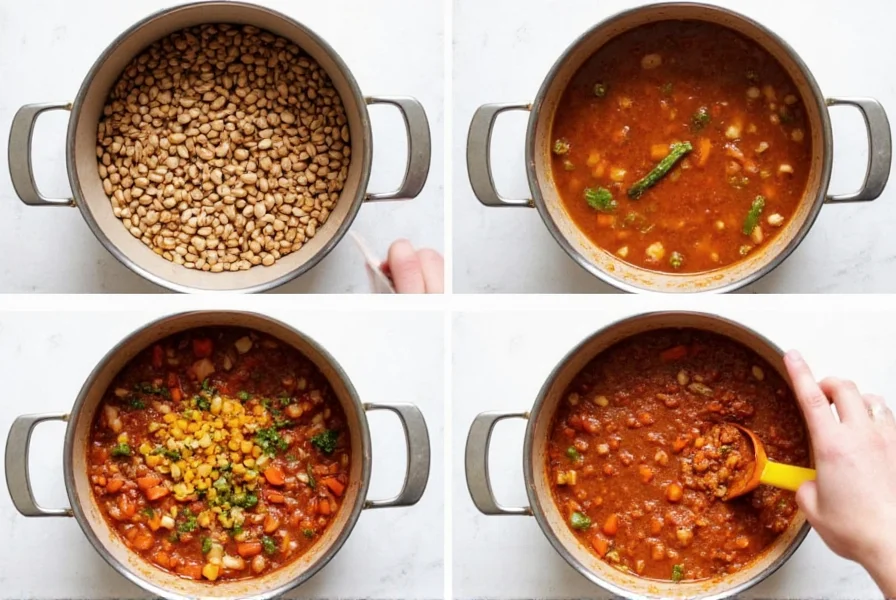Creating the perfect vegan bean chili requires understanding the balance of flavors and textures that make this dish satisfying. Unlike meat-based versions, vegan bean chili relies on layered spices and umami-rich ingredients to achieve depth. The foundation starts with sautéing aromatic vegetables before adding beans and tomatoes. Using three types of beans provides varied textures while maintaining consistent flavor absorption. Fire-roasted tomatoes add natural sweetness that balances the heat from chipotle peppers and smoked paprika.
| Core Ingredients | Quantity | Preparation Notes |
|---|---|---|
| Diced onions | 1 large | Yellow onions provide best flavor foundation |
| Garlic cloves | 4 | Minced fresh for maximum aroma |
| Red bell pepper | 1 | Diced small for even distribution |
| Kidney beans | 15 oz can | Rinsed to reduce sodium |
| Black beans | 15 oz can | Rinsed and drained |
| Pinto beans | 15 oz can | Essential for authentic texture |
| Fire-roasted tomatoes | 28 oz can | Provides natural sweetness |
| Chili powder | 3 tbsp | Use quality brand for best flavor |
The Secret to Flavorful Vegan Bean Chili
Many home cooks struggle with bland vegan chili because they skip the flavor-building steps. Start by sautéing onions, garlic, and bell peppers in olive oil until caramelized—this creates the flavor base. Add spices directly to the hot vegetables to toast them, releasing essential oils. For umami depth, include one tablespoon of soy sauce or tamari (gluten-free option) and a teaspoon of cocoa powder. The cocoa enhances richness without adding chocolate flavor.

Step-by-Step Cooking Process
Follow these steps for restaurant-quality vegan bean chili at home:
- Sauté diced onions, garlic, and bell peppers in olive oil for 8-10 minutes until softened
- Add chili powder, cumin, smoked paprika, and oregano directly to vegetables
- Stir spices for 1 minute until fragrant
- Pour in fire-roasted tomatoes and vegetable broth
- Add all three types of rinsed beans
- Include secret ingredients: soy sauce and cocoa powder
- Simmer uncovered for 30-45 minutes, stirring occasionally
- Adjust seasoning with salt, additional spices, or lime juice
Customizing Your Vegan Bean Chili
Vegan bean chili adapts beautifully to personal preferences. For extra protein, add cooked lentils or textured vegetable protein. If you prefer spicy vegan bean chili, include one diced jalapeño with the vegetables or add cayenne pepper to taste. For a smoky vegan bean chili, increase smoked paprika to 2 teaspoons or add liquid smoke sparingly. Those seeking quick vegan bean chili can use pre-cooked beans and reduce simmering time to 20 minutes while still achieving good flavor.

Nutritional Benefits of Bean-Based Chili
This high-protein vegan bean chili delivers 15 grams of protein per serving from the combination of three beans. The fiber content (13 grams per serving) supports digestive health and creates lasting fullness. Rich in iron, magnesium, and vitamin C from the vegetables, this dish qualifies as a nutritious vegan bean chili that satisfies both taste and health requirements. The absence of meat makes it naturally lower in saturated fat while providing complex carbohydrates for sustained energy.
Storage and Reheating Tips
Vegan bean chili improves in flavor overnight as spices meld. Store in airtight containers for up to 5 days in the refrigerator or freeze portions for up to 3 months. When reheating meal prep vegan bean chili, add a splash of vegetable broth to restore moisture. The dish works exceptionally well in slow cookers—simmer on low for 6-8 hours after initial vegetable sautéing.
Frequently Asked Questions
Can I make vegan bean chili without tomatoes?
Yes, substitute tomatoes with 2 cups of roasted red pepper puree and 1 cup of vegetable broth. Add 1 tablespoon of apple cider vinegar for acidity to balance the flavors in your tomato-free vegan bean chili.
Which beans work best in vegan chili?
The ideal combination uses kidney beans for meaty texture, black beans for earthiness, and pinto beans for creaminess. For authentic vegan bean chili, maintain this three-bean foundation while experimenting with additional varieties like cannellini or navy beans.
How do I thicken vegan bean chili?
Simmer uncovered for additional 10-15 minutes to reduce liquid. Alternatively, mash 1/2 cup of beans and stir back into the pot. For gluten-free vegan bean chili, avoid flour-based thickeners and use cornstarch slurry (1 tablespoon cornstarch mixed with 2 tablespoons cold water) instead.
Can I prepare vegan bean chili in an Instant Pot?
Absolutely. Use sauté function for vegetables and spices, then add remaining ingredients. Pressure cook on high for 10 minutes with natural release. This method creates a quick vegan bean chili ready in under 30 minutes while maintaining deep flavors.











 浙公网安备
33010002000092号
浙公网安备
33010002000092号 浙B2-20120091-4
浙B2-20120091-4